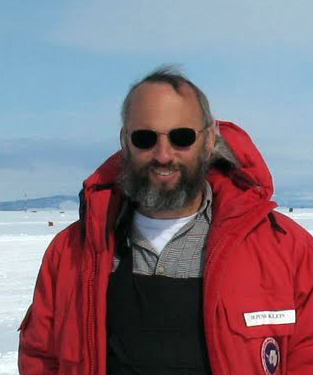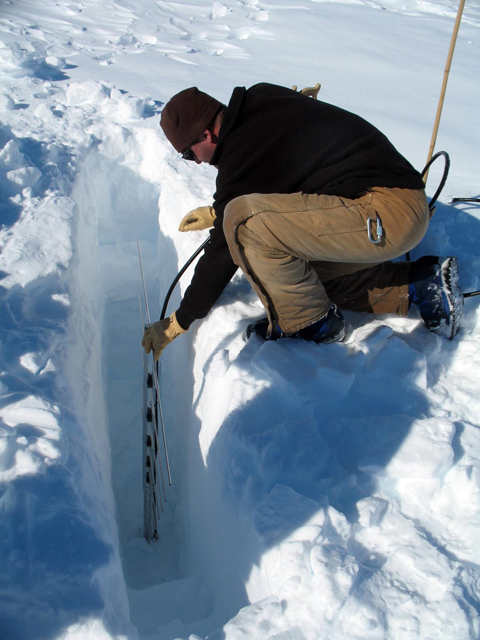Tuning into neutrinosARIANNA proposes to use radio waves to capture the elusive particlesPosted March 26, 2010
The Chinese philosopher Lao Tzu once wrote that a journey of a thousand miles begins with a single step. For a team of physicists hoping to learn more about the high-energy universe, the journey toward building an array of 10,000 instruments for just that purpose began this past season with a single prototype deployed on a 600-meter-thick ice shelf. More Information
“We’re trying to find the sources of ultra-high-energy cosmic rays in the universe,” explained Spencer Klein Nothing on Earth — not even the Large Hadron Collider 
Spencer Klein
“That tells us that somewhere there are these extremely high-energy accelerators in the universe,” said Klein, a physicist in the Nuclear Science Division at Lawrence Berkeley National Laboratory (LBNL) Unfortunately, cosmic rays themselves are lousy tracers for getting back to the source of these high-powered galactic accelerators. Interstellar magnetic fields bend the electrically charged particles as they hurl through space, meaning there’s not a straight line back to the spot that first spit them out. Physicists need a different type of probe — a neutrino. Yes, the same subatomic particle with no charge and little mass that the IceCube Neutrino Observatory IceCube uses strings of sensors buried deep in the icecap to detect not the neutrino itself but the light created by neutrino collisions in the ice. The collision creates a negatively charged particle called a muon, which continues in the same direction as the neutrino. And as it travels through the ice, it produces a cone of blue light (called Cherenkov radiation) that IceCube detects. But Klein and his colleagues, including the project’s principal investigator Steve Barwick The grand scheme is called ARIANNA, for Antarctic Ross Ice shelf Antenna Neutrino Array. It would consist of up to 10,000 stations, each consisting of four to eight TV-like antennae embedded just below the surface of the ice, spread over more than 100 square kilometers. The antennae are connected to an electronics box for processing the radio pulses. Solar panels would charge the detector in the summer. For the winter, Klein said the team is testing a wind generator on the prototype instrument, which would place limits on power consumption during the dark Antarctic months. The ARIANNA detectors search for radio waves produced by neutrino interactions in the ice. The radio pulses come from the particle showers produced when the neutrino converts its energy into matter. Radio waves in ice are particularly attractive, Klein said, because you get radio emissions from the entire particle shower. Also, radio waves can travel up to a kilometer in the ice. “That means if you’re building stations you can put them on a roughly 1-kilometer grid, and you need fewer of them,” Klein said. The physicists also believe the water below the ice shelf is an additional advantage. The ice-water interface reflects radio waves, bouncing back any emissions from downward-traveling neutrinos. Popular theories for the source of high-energy particles include something called active galactic nuclei, which are galaxies with a super massive black hole at the center. Colliding black holes or collapsing giant stars are also possible sources. “Those are just theories, and it could just as well be something else,” Klein said. Klein, LBNL engineer Thorsten Stezelberger, and Martha Story from McMurdo’s Berg Field Center, spent 11 days in a field camp setting up the prototype radio detector, which will stay out for a year. In addition, work included characterizing properties of the ice, such as measuring the radio wave reflections from where the ice meets the water. Klein, also involved with the IceCube experiment, has been to the South Pole, but the ARIANNA fieldwork was new for the physicist. “Going out with three people and a tent was a very different experience. It was a small group, so everybody was doing everything,” he said. If all goes as planned — the prototype station survives the winter, the site demonstrates the necessary properties — the ARIANNA team hopes to move forward a proposal to deploy a five- to seven-station array with new hardware specifically designed for the project. “That would be the next step. You don’t go from one station to thousands,” Klein said. NSF-funded research in this story: Steven Barwick, University of California-Irvine, Award No. 0839133
|



For USAP Participants |
For The Public |
For Researchers and EducatorsContact UsU.S. National Science FoundationOffice of Polar Programs Geosciences Directorate 2415 Eisenhower Avenue, Suite W7100 Alexandria, VA 22314 Sign up for the NSF Office of Polar Programs newsletter and events. Feedback Form |




